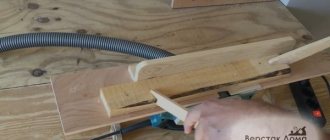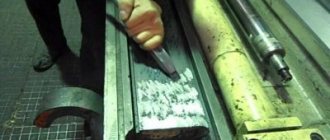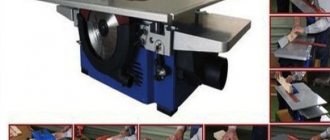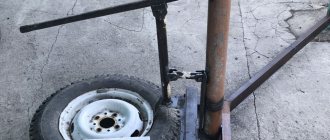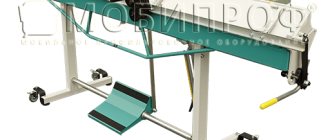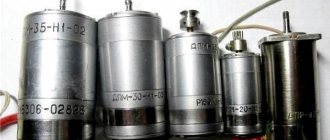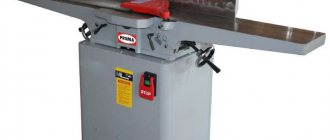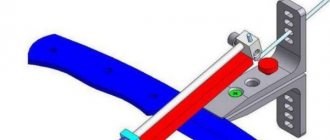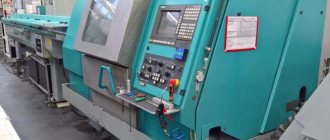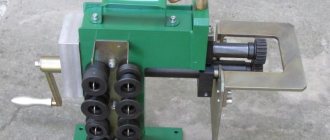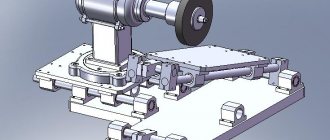Shtangenreysmas [edit | edit code ]
Shtangenreysmas
(gauge gauge) is used to measure the heights and marking of products installed on the slab [1]. The height gauge consists of a rod rigidly connected to the base. A frame with a vernier moves along the rod, like a caliper. The frame has a bracket on which a measuring or marking leg is attached.
Any carpenter or mechanic's tool kit must have a thickness planer. Its function allows you to correctly record dimensional indicators, make accurate projections and determine the correct position of certain objects or structures in construction and installation. However, the question of what a thicknesser is suggests an ambiguous answer. On the one hand, it can be a simple wooden device with two or three components, and on the other, a full-fledged processing machine in which the thicknesser function is provided as an auxiliary one.
What is the function of a surface planer?
Typically, a surface planer is purchased for working with wood. As already noted, the classic device allows you to record the geometric parameters of the workpiece, take measurements, transfer data from drawings to real materials, etc. However, a full-fledged thicknesser for wood in the form of a machine has broader capabilities. If manual models are used only for marking, then desktop equipment also carries out processing operations on site. But here too there is some specificity. Correction of workpieces in shape and size is carried out using the type of jointing machines or planes. That is, this is precisely a correcting machine, similar in functionality to grinding machines. Such units are used both for professional purposes in furniture factories and at home during the construction of small objects or structures using wood material.
Where is a thickness planer used?
Almost no construction takes place without thicknessing and jointing work, and it doesn’t matter at all whether you are building a house or a utility room. A device such as a thickness planer allows you to cut a block or board to the required length and cut dimensions, as well as level it. Thanks to this type of equipment, the wood material is straight and uniform, which is necessary for work such as building the walls of a wooden house or laying floors.
Thicknessing machine allows you to cut a block or board to the required length and cut dimensions, as well as level it
Design of a conventional thicknesser
The simplest model of this type is formed by three components - a basic supporting post with a dimensional scale, a clamp or gripping device and a small device for applying markings. A characteristic feature of budget home surface planers is the material they are made of - these are models made from the same wood, but from hardwood. By design, the finished device is a block in which there is a rectangular hole. By moving functional elements in the form of slats, the user can perform dynamic markings. To understand what a traditional thickness planer is, you should also take into account the importance of the drawing components - the pins. There may be several of them. For example, a double marking configuration allows markings formed by parallel lines.
Read also: How to make guides for a machine
Purpose of a surface planer
In order to understand the importance of having a surface planer in the workshop, just look at any piece of carpentry: a table, a chair, a wardrobe, a bed... They all consist of boards or bars that have the same thickness along their entire length and edges that are strictly parallel to each other. The parallelism of the edges and constant thickness give the product a perfect look that pleases the eye, demonstrating the accuracy and skill of the craftsman. This kind of work cannot be done without a thickness planer.
- A thicknesser is a tool used to draw lines on a part at a given distance.
- Also in everyday life, a thicknesser is a woodworking equipment designed for planing workpieces to size according to a given thickness.
If in a conversation there is a fear that the interlocutor will not understand which type of thicknesser we are talking about, then the tool for applying markings is called a marking thicknesser, and woodworking equipment is called a thicknesser.
The word "reismus" came into Russian from South German. In modern German, this instrument is called “streichmas”, that is, a device for applying strokes. German carpenters also use the word “raismas”. In Russian, the “half-German” pronunciation of the name of the instrument is often found: “reismas”.
Features of machines with surface thicknessers
Easel models are radically different from conventional thickness planers. They are designed for mechanical processing of wood material using knives. As a rule, a multifunctional household woodworking machine with a thickness planer consists of a bed, a working platform and the mentioned knife elements. The operator's role during operation may vary. In budget models, where automatic systems are not provided, he himself feeds the workpiece and receives it from the other side of the working surface. But there are also automatic models that can perform serial processing without operator control.
It is important to take into account the differences between this type of machines and jointing units. Here again it is worth turning to the question of what an easel-type thicknesser is. This is a machine that, using knives, performs grinding or planing operations. In turn, jointing machines can have the same design, but thanks to a larger number of knives (at least three), they realize deep removal of excess mass from the surface of the workpiece.
Scope of application
All woodworking enterprises have such equipment. It helps solve the following problems:
- Even out the thickness of the workpieces.
- Accurately cut panels and boards intended for finishing floors and walls.
- Making a wooden surface perfectly smooth.
- Perform planar processing.
Before starting to work on the thickness planer, it is necessary to carry out a thorough adjustment. What to pay special attention to:
- The machine is installed on the desktop clearly and correctly, without distortions.
- Do not place the grooved roller low.
- Adjust the pressure of the rear pressure pad on the surface being treated.
- Make sure that there is no very high pressure on the lower rollers, thanks to which the wood is fed above the table level.
- Check the functioning of the exhauster. If it malfunctions, chips may end up in the rear main roller.
- Look at the installation of the cap visor.
Tips for using the device
The main thing during the installation process is to ensure a stable position of the structure. In this case, the machine can be floor-standing or table-top. In both cases, securely fixing the machine to the surface will ensure an accurate result. It is advisable to use special fasteners that will immobilize the surface planer. The instructions for desktop models, for example, recommend fixing the unit using 4 complete bolts to a workbench or stable working platform. Work begins after the drum, equipped with blades, reaches the proper speed. Next, you can install the workpiece flush on the table surface. When planing heavy and long objects, you should slightly lift the outer parts of the workpiece on both sides of the cut. This will prevent gouging or cutting off excess parts.
Design and principle of operation of a thickness planer
The device of a thickness planer consists of the following mechanisms:
- Knife shaft. This element is located on the electric surface planer motor. Cutting knives in the shape of spirals, characterized by a low noise level, are fixed on it.
- Desktop. It is a horizontal surface designed to form the depth of cut. This element of the machine is made of wood and carefully polished. The length of the work table is 0.1 m.
- The bed is a cast iron base on which the work table and knife shafts are mounted. This mechanism ensures the stability of the machine. The bed is made of cast iron and is connected to the work table using clamps - tools for fixing parts.
- Drive unit. This mechanism consists of an electric motor, a pulley, belts and drive chains. The drives of powerful machines are equipped with two electric motors.
- Screw device. It is designed to determine the caliber of the planing tool. With its help you can set the cutting thickness.
- Rollers. They are part of the feed mechanism of the machine and are divided into 2 pairs. The first pair is placed above the path of the board. The second pair is located parallel to the first. The rollers are driven by an electric motor.
- Suction system. It is designed to remove sawdust and tiny wood dust generated during planing of bars. A vacuum cleaner can also be used as a suction system.
- Top knot. Consists of rear and front rollers. This mechanism improves grip on the workpiece being processed. It allows you to control the direction of movement of the bar. The rear shaft of the upper unit has a grooved surface. The front shaft has straight sides.
- Bottom node. Used to feed the workpiece onto the work table.
- Clamping unit. Necessary for maintaining optimal board temperature during planing. It consists of spring mechanisms and claw grips.
- Guide slides. Designed to move the machine and its main components in several directions.
The operating principle of a thickness planer is to process wood using the flat planing method. The processed bars are installed under the cutting knives and fixed on the work table. By applying the knife blades to the surface of the wood, the workpieces are calibrated. As a result, the part takes on the desired shape.
Modern models of machines are equipped with an automatic workpiece feeding system. It is represented by rollers that press the bars against a rotating shaft.
If there are automatic feeding mechanisms, you can adjust the pulling speed and the angle of inclination of wooden products. This allows you to improve the quality of processing parts with non-parallel edges. Using these mechanisms, lumber up to 1 m wide can be cut. The cutting depth is on average 155 mm. Thicknessing machines with automatic mechanisms are durable and have a high level of productivity.
Manufacturers of surface planers
In one modification or another, surface thicknessers are present in the product range of almost all major manufacturers of construction tools and equipment. In particular, Makita and Dewalt offer tabletop thicknessers for working with small volumes. This is a reliable technology that is characterized by durability, operational flexibility and high processing efficiency.
Domestic manufacturers also offer interesting options. For example, the Anchor Corvette-21 model is quite suitable for a small workshop that processes lumber. If you need a universal thicknesser for a wide range of standard operations, then you can turn to the “Caliber” line. This brand also produces affordable and durable models.
How to choose a thickness planer?
First of all, technical and operational characteristics are taken into account. For example, by the depth of the cut you can understand which layer from the surface the machine can remove in one pass. This value varies on average from 1 to 3 mm. No less important is the width of the cut, on which the machine’s ability to serve workpieces of one or another format basically depends. Household models usually work with widths in the range of 300-330 mm. Often power is also important. It will determine the productivity of a multifunctional household woodworking machine with a thickness planer in a specific design. This figure can be 1.5 kW or 2 kW. Models close to the first value are suitable for private needs, and machines with a power of more than 2 kW belong to the industrial segment.
Description of the tool
Thicknessers are machines for wood processing that allow planing and leveling the surface of lumber to produce boards of a given thickness. This type of wood processing is carried out by using lumber in construction and making various structures from them. Planing equipment is in demand on the market and is popular with ordinary homeowners who independently engage in construction at the dacha and in their own home.
Self-made surface planers are distinguished by their simplicity of design, which allows them to be made using an electric planer, grinder and other similar power tools as a basis. You just need to make sure that you have the appropriate diagram, which you should adhere to when making homemade equipment.
Advantages of homemade machines
A do-it-yourself jointing machine is distinguished by its versatility of use. The functionality of such equipment will be sufficient for high-quality wood processing. Using homemade machines, you can not only plan lumber, but also finish the boards, giving them the required thickness and a perfectly flat surface.
The advantages of hand-made surface planers include the following:
- Simplicity of the device of a planer for wood.
- Functionality and versatility of use.
- Affordable cost of the components used.
- Possibility of subsequent upgrades.
- Reliability and maintainability of equipment.
To make a homemade surface planer with your own hands, you can use an electric planer, which is used to create a machine that allows for high-quality wood processing, including planing, edge processing and chamfering. It is only necessary to select a high-quality project for the manufacture of a homemade thickness planer, which will be the key to producing reliable and universally-usable equipment.
What are there
If a person has to deal with wood, then if there is a significant amount of it, the question arises of how to plan the boards quickly and efficiently. You can do this manually, but it takes a long time and is too difficult. Special units with knife shafts, into which the workpieces are fed automatically, will help speed up and facilitate the process.
What is it and what variants are available? The best manufacturers have saturated the market with a variety of products, presenting various types of machines for public viewing. Their distinctive features can be viewed in the comparative table:
| Thicknesser type | Description |
| Unilateral | They belong to the household category. Plane one side of the workpiece. Used for home. There are many popular models. |
| Double sided | Considered professional. Both the lower and upper surfaces are treated. They have great power and significant speed. |
| Three-, four- and multi-sided | Industrial options that process wood on both sides. They are used to give parts the correct geometric shape and provide the edges with the necessary texture. They differ in significant parameters, weight and complexity of operation. The main advantage is productivity. |
Classification by design
Devices for wood processing are:
- Mobile. They are lightweight, small in size, usually installed on top of a workbench and process small parts at home.
- Stationary. Larger and heavier than their brothers. Used for processing large workpieces.
Regardless of the popularity of the model and its structure, the devices are equipped with automatic feeding. The existing roller system presses the wood against the shaft and “transports” it until it reaches the working surface.
The units have the following characteristics:
- power varies from 1.5 to 8 kW;
- maximum planing width – 38 cm;
- depth – 3 mm.
Models differ not only in functionality, but also in shaft rotation speed, energy consumption, number of knives, characteristics, average price, and so on.
Difference in functionality
In order not to make mistakes when choosing, you need to have information about what machines manufacturers produce and what functions they are equipped with. Let's look at the main options:
- Household. Main characteristics: compact, light weight, can be installed in a small room. They have low and medium power. Inexpensive in price. Used for processing small workpieces and cutting to a small depth (from 1 to 1.5 mm). In most cases, feeding is done manually. Unable to handle deep cutting of surfaces. Working with them requires significant physical effort. Not used for work with workpieces on an industrial scale.
- Industrial. The best models have high speed and significant power, and the ability to make deep cuts. Takes up a lot of free space in the room. There is a function of automatic feeding of workpieces. Connects to a 380 V power supply. High power requires its own cooling system. The blades can be installed on one side or on both sides. Main structural elements: double stand, movable drum, knives. It is possible to adjust the cutting depth thanks to the presence of a control unit.
- Planing and thicknessing. They are used if there is a need to accurately turn parts, products and other accessories from wood with your own hands. It is able to provide a perfectly flat surface, reduce thickness using the longitudinal method, and eliminate various defects, such as splinters, cuts, bulges, etc. Some manufacturers provide the possibility of reciprocating movements of the device. Which company is better to buy depends on the preferences of the craftsmen. The product is produced by both foreign companies and domestic companies. Every year new products are produced that top the rating of quality products of this kind.
- Joint-thicknessing. Milling is performed by processing the base base using a knife shaft installed under the table. There are double-sided and single-sided. The first option is used more often both for self-processing at home and in industrial settings.
Making a thicknesser with your own hands
On the Internet you can find various designs for homemade jointers, which are distinguished by their functionality and ease of manufacture. Subsequently, you should adhere to the scheme on hand, selecting the appropriate components and correctly assembling the machine, the functionality of which will fully meet the requirements of homeowners.
Necessary materials
There are many options for making homemade planing machines, which will differ in their basis. The easiest way to make such a tool is using an electric planer or jigsaw.
To perform a surface planer you will need the following:
- Electric planer.
- Screwdrivers and keys.
- Ruler and corner.
- Screwdriver.
- Drive sprockets.
- Bicycle chain.
- Wooden beams and slats.
- A sheet of plywood 15 millimeters thick.
- Long threaded screws.
Plywood and timber will be required to make the base of the machine and the manual table, on which the electric planer and other elements responsible for the functionality and safety of using the equipment will subsequently be attached.
It is necessary to use high-quality wood, which is additionally recommended to be treated with impregnations against rotting.
Step-by-step instruction
Making a surface planer is not difficult, so almost anyone can handle this type of equipment.
The following work will need to be done:
- A sheet of plywood 15 millimeters thick is cut into a rectangle with a width of 400 millimeters and a length of 500 millimeters.
- In the middle of the rectangle, a mount-stand is made, to which the electric planer will subsequently be attached. The stand for the surface planer is made from a piece of plywood and is attached to the base with screws from the back side, which will ensure the strength and reliability of the machine made by yourself.
- A platform for an electric planer is being built. An opening is made in the platform, which is identical in size to the shape of an electric planer. The electrical appliance used is attached to the platform with screws and clamps.
- A drive mechanism is mounted on the base of the platform, which is responsible for raising and lowering the platform with the surface planer. Large-threaded screws are attached to the corners of the base. Subsequently, four sprockets are attached to the installed screws.
- Small stands are made from plywood, on which the platform with the upper part of the surface planer is installed. The stands are attached to the platform with screws or similar fasteners. It is necessary to think about the proper placement of the cable from the electric planer, which should be located at a short distance from the working saw of the planer.
- Fix the handle, which is intended to adjust the location of the platform. The easiest way is to fix the handle with a long screw with a large thread or secure it with several screws at once.
- At the final stage of work, an indicator and a measuring bar are installed.
- Using a measuring strip, you can measure the thickness of the processed lumber. It can be made from a small piece of plastic or wooden ruler. The indicator can be made from a pointer or a tin strip.
Read also: Do-it-yourself hitch for a walk-behind tractor
This is the simplest surface planer design that can be done at home. On the Internet you can find various drawings of a thickness planer made from an electric planer with your own hands, which will differ in their functionality and manufacturing method.
Subsequently, you can upgrade the completed basic design of the machine by adding additional tools, which expands the functionality of the equipment.
Safe to use equipment
When performing any homemade woodworking machine, you need to take care of the safety of working on the equipment. If possible, the cutter should be covered with protective devices, and working on a machine where the working cutting element does not have any protection is prohibited. Most home-made planer manufacturing schemes have high-quality protection for the electric planer, which eliminates injuries when working with such equipment.
- When working with homemade tools, you must use safety glasses and work gloves. In particular, the latter will be required when working with coarse, dense workpieces, when beating of a homemade surface planer from an electric planer is observed when processing the material.
- The studs used must not have cracks, defects or damage. If cracks or damage are found, the defective parts of the machine should be replaced.
If you follow the simplest safety measures, working with a thickness planer will not present any difficulty, and the machine itself will last for many years. Using homemade machines, it will be possible to perform high-quality wood processing, saving on the purchase of industrial milling cutters.
Thicknesser for wood
Among the closest relatives of the thickness planer are the most famous and popular systems:
- Wood planing machine, removes the upper, roughest part of the workpiece after cutting logs and beams on powerful circular saws;
- A jointing machine is used for preliminary semi-finishing of the surface of a board or slab of wood;
- The grinding machine is used for finishing before polishing wood or processing with varnish polishes and wax mastics.
The first two types of machines differ only in the size of the work table, the number of cutting edges, and cutting speed. The structure of the frame, knife block, drive and system for feeding wood workpieces are in many ways similar. The sanding machine uses sanding drums and belts instead of knives.
For your information! Between the operations of grinding and planing wood, it is assumed that the workpiece will be processed using a thicknesser type drum knife.
With the correct selection of modes, the quality of wood processing on a surface planer turns out to be quite high, which often makes it possible to avoid sanding the wooden surface.
In many cases, when working with light and medium-density workpieces, jointing and finishing cutting operations are performed on one jointing-thicknessing machine. It is enough just to consistently reconfigure the cutting mode and rotation speed of the knife block. One machine actually replaces two.
Rules for working with milling machines
Knowledge of the rules for working with a surface planer will improve the quality of lumber processing, relieving the homeowner of any difficulties in operating the tool he has made.
The operating rules are as follows:
- The machine pin is installed in the correct position.
- Depending on the size of the parts being processed, the thicknesser stroke is set, for which the guide bar is fixed.
- The machine is slightly tilted, which opens the cutting part of the pin, the processed lumber is placed inside, after which the tool is pulled towards itself, this allows the cutting head to remove a thin layer of wood.
- Over and over again, forward movements are performed with the head of the thicknesser, removing a layer of wood from the processed lumber, achieving their perfectly flat surface.
A properly assembled thickness planer based on an electric planer will not be inferior to expensive factory equipment in terms of functionality, efficiency and productivity. You just need to find a high-quality plan for manufacturing a surface planer on the Internet and then follow the drawings when assembling an electric machine. The easiest way to make such a tool is on the basis of an electric plane, which is mounted on a plywood base. The simplest thicknesser, made independently, will differ in functionality in use, guaranteeing high-quality wood processing.
